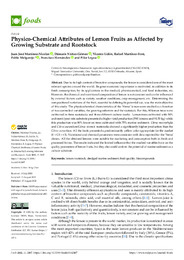Por favor, use este identificador para citar o enlazar este ítem:
https://hdl.handle.net/11000/34282Registro completo de metadatos
| Campo DC | Valor | Lengua/Idioma |
|---|---|---|
| dc.contributor.author | Martinez Nicolas, Juan Jose | - |
| dc.contributor.author | Núñez-Gómez, Dámaris | - |
| dc.contributor.author | Lidón Noguera, Vicente | - |
| dc.contributor.author | Martínez Font, Rafael | - |
| dc.contributor.author | Melgarejo Moreno, Pablo | - |
| dc.contributor.author | Hernández, Francisca | - |
| dc.contributor.author | Legua, Pilar | - |
| dc.contributor.other | Departamentos de la UMH::Producción Vegetal y Microbiología | es_ES |
| dc.date.accessioned | 2025-01-10T17:01:34Z | - |
| dc.date.available | 2025-01-10T17:01:34Z | - |
| dc.date.created | 2022-08-17 | - |
| dc.identifier.citation | Foods 2022, 11(16), 2487 | es_ES |
| dc.identifier.issn | 2304-8158 | - |
| dc.identifier.uri | https://hdl.handle.net/11000/34282 | - |
| dc.description.abstract | Due to its high content of bioactive compounds, the lemon is considered one of the most relevant species around the world. Its great economic importance is motivated, in addition to its fresh consumption, by its applications in the medical, pharmaceutical, and food industries, etc. However, the chemical and nutritional composition of lemon is not constant and can be influenced by external factors such as variety, weather conditions, crop management, etc. Determining the compositional variations of the fruit, essential to defining its potential use, was the main objective of this study. The physicochemical characteristics of the ‘Verna’ lemon were studied as a function of two controlled variables, the growing substrate and the rootstock. For this, 90 lemon trees were cultivated in three rootstocks and three different culture media. Lemon trees cultivated with 50% sediment/peat mix substrate presented a higher total production (590 lemons and 90.53 kg) while this production was 80% lower on trees cultivated with 75% marine sediment. Citrus macrophylla and Citrus aurantium/Citrus sinensis rootstocks showed a significantly higher production than the Citrus aurantium. All the fruits presented a predominantly yellow color appropriate for the market (0 < CI < +5). Nutritional and chemical parameters were consistent with data reported for the ‘Verna’ clones. All the obtained lemons were suitable for marketing and consumption both in fresh and processed forms. The results indicated the limited influence that the studied variables have on the quality parameters of lemon fruits, but they also could confirm the potential of marine sediment as a culture substrate | es_ES |
| dc.format | application/pdf | es_ES |
| dc.format.extent | 16 | es_ES |
| dc.language.iso | eng | es_ES |
| dc.publisher | MDPI | es_ES |
| dc.rights | info:eu-repo/semantics/openAccess | es_ES |
| dc.rights | Attribution-NonCommercial-NoDerivatives 4.0 Internacional | * |
| dc.rights.uri | http://creativecommons.org/licenses/by-nc-nd/4.0/ | * |
| dc.subject | Lemon rootstock | es_ES |
| dc.subject | Dredged marine sediment | es_ES |
| dc.subject | Fruit quality | es_ES |
| dc.subject | Biocompounds | es_ES |
| dc.title | Physico-Chemical Attributes of Lemon Fruits as Affected by Growing Substrate and Rootstock | es_ES |
| dc.type | info:eu-repo/semantics/article | es_ES |
| dc.relation.publisherversion | https://doi.org/10.3390/foods11162487 | es_ES |

Ver/Abrir:
Physico-Chemical Attributes of Lemon Fruits as Affected.pdf
1,36 MB
Adobe PDF
Compartir:
 La licencia se describe como: Atribución-NonComercial-NoDerivada 4.0 Internacional.
La licencia se describe como: Atribución-NonComercial-NoDerivada 4.0 Internacional.
.png)